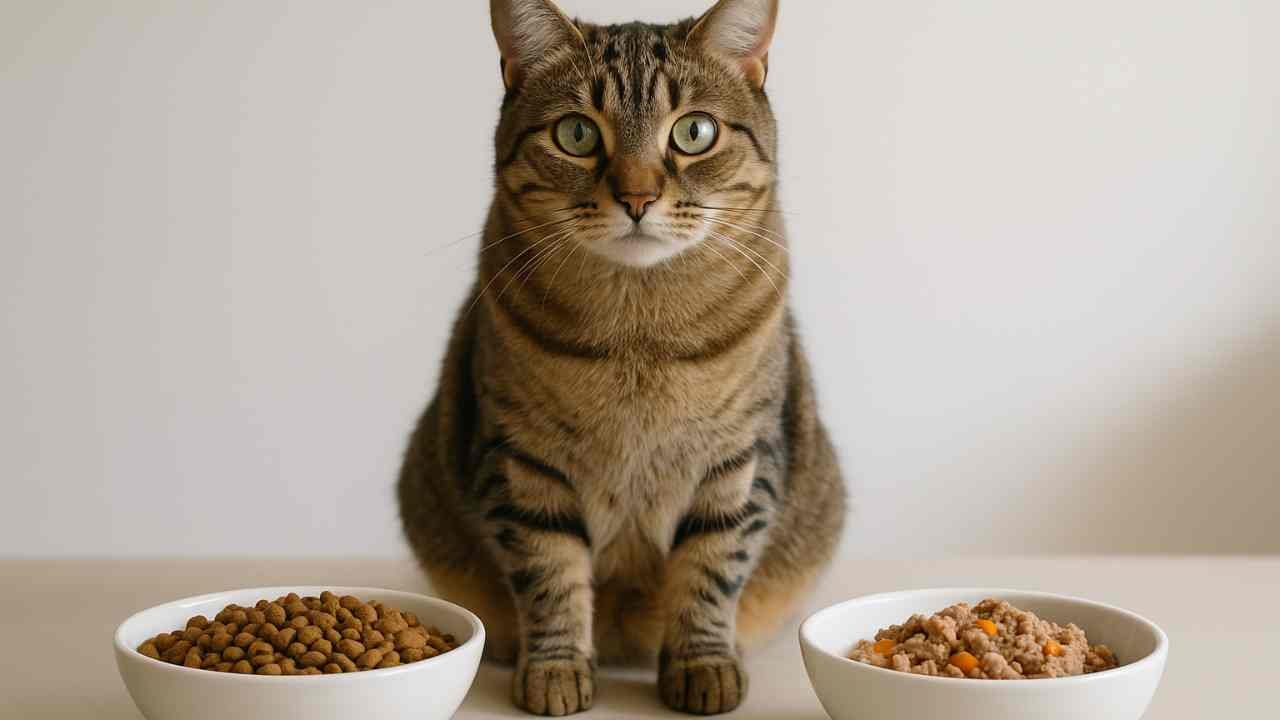Introduction
Choosing the right diet for your cat can be overwhelming — especially when you’re deciding between wet food, dry food, or even homemade options.
Pet owners often ask:
“Is dry food enough for my cat?”
“Is homemade wet food healthier?”
“What should I feed for long-term health?”
In this guide, we’ll break it all down clearly, so you can make the best choice for your cat’s health, hydration, and happiness.
✅ Quick Overview: What’s the Difference?
| Type | Description |
|---|---|
| Dry Cat Food (Kibble) | Commercial crunchy food with low moisture |
| Wet Cat Food (Canned) | Moist, soft food with higher water content |
| Homemade Wet Food | Freshly cooked meals prepared at home with tailored ingredients |
Each type has its benefits and drawbacks — let’s explore them in detail.
🥫 What is Homemade Wet Cat Food?
Homemade wet cat food is made using fresh, cooked ingredients like chicken, turkey, or fish, combined with safe fats, small carbs (optional), and added supplements.
✅ High moisture
✅ No preservatives or fillers
✅ Custom nutrition
It can be gently pureed or served in soft chunks based on your cat’s preference.
🐾 Benefits of Homemade Wet Cat Food
| Benefit | Why It Matters |
|---|---|
| Moisture-rich | Supports kidney, bladder, and overall hydration |
| Better ingredient control | Avoid allergens, fillers, and by-products |
| Fresh and nutrient-dense | Made with human-grade ingredients |
| Customizable | Tailored for health issues (e.g. kidney, allergies) |
| Better taste | Cats often prefer fresh, soft food over kibble |
✅ Ideal for picky eaters, senior cats, and cats with urinary issues
🧪 Drawbacks of Homemade Wet Cat Food
| Drawback | Risk |
|---|---|
| Requires effort | Time-consuming to prep and balance |
| Nutrient imbalance | If not supplemented correctly |
| Needs refrigeration | Short shelf life (2–3 days max) |
| Vet guidance needed | Must match cat’s age and health status |
⚠️ Cats require taurine, calcium, and vitamin A — these must be supplemented if not naturally present.
🍘 What is Dry Cat Food (Kibble)?
Dry food is a highly processed, low-moisture product made from grains, proteins, fats, and vitamins — baked into small bite-sized pieces.
✅ Benefits of Dry Cat Food
| Benefit | Why It’s Popular |
|---|---|
| Convenient | Easy to store, scoop, and serve |
| Affordable | Cost-effective for multiple-cat households |
| Longer shelf life | Can be stored for months |
| Supports dental health | Helps reduce tartar buildup (moderately) |
❌ Drawbacks of Dry Cat Food
| Drawback | Issue |
|---|---|
| Low moisture | Can lead to dehydration or urinary issues |
| Highly processed | Contains fillers, artificial colors/flavors |
| Risk of overeating | Cats tend to graze on kibble all day |
| Less palatable | Many cats find it boring or dry over time |
⚠️ Not ideal for cats with kidney problems or older age groups
🔍 Comparison Table – Homemade Wet vs Dry Food
| Feature | Homemade Wet | Dry Food |
|---|---|---|
| Moisture Content | ✅ High (70–80%) | ❌ Low (5–10%) |
| Ingredient Control | ✅ Full | ❌ Limited |
| Shelf Life | ❌ Short (2–3 days) | ✅ Long (months) |
| Nutritional Balance | ⚠️ Needs careful planning | ✅ Pre-formulated |
| Dental Benefit | ❌ Minimal | ⚠️ Moderate |
| Cost | ⚠️ Slightly higher | ✅ More affordable |
| Digestibility | ✅ Easier | ❌ May cause constipation |
| Taste | ✅ Often preferred | ❌ Less appealing to picky cats |
🧠 What Do Vets Recommend?
Most vets agree:
- ✅ Moisture is critical for cats (especially in hot climates or older age)
- ⚠️ Kibble is fine in moderation, but not ideal as the only food
- ✅ Homemade wet food is great if:
- Balanced
- Vet-guided
- Freshly prepared
✅ Best diet = combo of wet + dry, or fully balanced homemade wet food
📝 Sample Homemade Wet Cat Food Recipe
Chicken & Pumpkin Bowl
Ingredients:
- 1/2 cup boiled chicken
- 1 tbsp mashed pumpkin (plain)
- 1 tsp fish oil
- 1/2 tsp taurine powder
- Add warm water or broth for extra moisture
Instructions:
- Cook and shred chicken
- Mix all ingredients well
- Serve slightly warm
- Store leftovers for 2 days in fridge
❓ FAQs – Homemade Wet Cat Food vs Dry
Q: Can I mix homemade wet food with kibble?
A: Yes — that’s a good way to transition and balance moisture intake.
Q: Is dry food okay for kittens?
A: Only as part of a vet-approved feeding plan. Kittens need high moisture.
Q: How do I store homemade food?
A: Use airtight containers in fridge (2–3 days) or freeze in portions.
Q: Will my cat get bored of dry food?
A: Yes, most do — adding fresh wet options improves appetite and variety.
🧾 Final Verdict – What’s Better?
If your priority is hydration, ingredient control, and freshness, then:
✅ Homemade wet cat food is better — but only if done right.
Dry food can be part of your cat’s routine, especially for budget and dental reasons, but it should not be the only source of nutrition.
For best results, consult your vet and rotate meals smartly.
